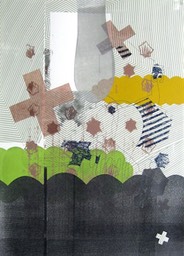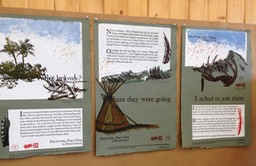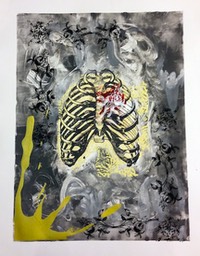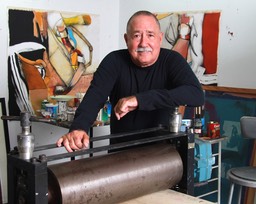South Florida printmaking community makes greater impression
Audio
Hear artist Lazaro Amaral talk about his approach to teaching.
BY GEORGE M. FISHMAN
SPECIAL TO THE MIAMI HERALD
8/10/2014
Who hasn’t overheard the dismissive comment during a visit to a gallery or museum: “Oh, that’s just a print.”
But limited-edition prints — signed and numbered serigraphs, etchings, lithographs and their brethren are original works of art, whether created in editions of a handful or several hundred.
Posters and reproductions, though, can be printed in unlimited numbers. Some images are sold in both categories. Think of Andy Warhol’s iconic soup cans. Available for less than $10 as reproductions, the original numbered silkscreen prints command tens of thousands of dollars.
South Florida’s community of printmakers and their kindred book artists is growing, diversifying and gathering to share ideas and resources. The region offers a multitude of venues to view these works of art as well as opportunities to learn to make them.
Said Kathleen Hudspeth, founder of Miami’s Turn-Based Press: “Though we will be publishing our own editions, and probably providing contract printing, the main focus of TBP is on community. We want to bring people together for the love of prints, works on paper and artists’ books.
The practical value of producing multiple copies from the creation of a single graphic design or text has led to the development of various techniques of printmaking over the centuries. Among the first was the woodcut, which remains popular today. It’s a straightforward proposition: The artist creates a design on a smooth board. Using knives and gouges, she cuts away the rest of the surface, leaving only the raised design. She brushes or rolls ink onto the raised area, places a dampened sheet of paper or fabric on it, rubs or applies pressure to assure good contact, removes the paper and voilá, a woodcut print.
This process can be repeated to produce as many copies as the artist has determined to be in the edition.
Letterpress involves the arrangement of carved or cast letters (moveable type) to prepare a printed text — possibly combined with a graphic image. All these are considered relief prints (as in a bas-relief surface). Each of the other main families of prints (intaglio, planographic and stencil) has its own expressive distinctions and technical challenges. Additionally, there’s photography and the digital world.
The widespread accessibility of multiples adds to their appeal and power — whether United Farm Workers posters recently shown at the Frost Museum; Toulouse Lautrec’s lithographic promotions for the Moulin Rouge (influenced by Japanese prints), or Shepard Fairey’s ubiquitous Obama Hope silkscreen.
Artist Tom Virgin, a printmaker, teacher and book artist, works hard to generate fruitful connections. Philosophically, he says, “That particular democratic multiple aspect has always been something that I wanted to do.”
Among Virgin’s pet projects is Sweat Broadsheet, initiated by a handful of colleagues who brainstormed at the Sweat Records store and then solicited their friends. Pairs of participants collaborate to create prints in which graphic images in diverse mediums are interwoven with equally diverse poetry and prose expressions. Virgin characterizes these as “distilled visual impressions of writing that goes back and forth.”
Sweat Broadsheet has developed a touring schedule (returning to Miami Dade College’s Kendall Campus gallery in September). It has a permanent home at the Jaffe Center for the Book at Florida Atlantic University, which is a treasury of one-of-a-kind and artist-made books — most of which use printmaking techniques. The Jaffe Center also maintains a series of printing presses, and under printmaker John Cutrone’s direction, offers residencies and workshops in which participants use vintage machines as part of their book making.
Artist books are a growing trend in South Florida, inspired in part by enthusiasts like the Sweat Broadside circle; also by the Sackner Archive of Concrete and Visual Poetry (a selection recently exhibited at the Pérez Art Museum Miami), Miami’s Knight Foundation-sponsored Turn-Based Press and by the Jaffe Center. Miami Dade College is also initiating WAIL (Word And Image Lab) to facilitate collaborations among the writing, visual and performing arts communities. The popularity of graphic novels and zines illustrates this confluence of writing, printmaking and book binding.
Prints are included in most exhibition venues. One gallery that specializes in prints is Gregg Shienbaum Fine Art, in the heart of Wynwood. It sells blue-chip artists like Warhol, Robert Indiana and Roy Lichtenstein, but the gallery also presents street artist crossovers Keith Haring, Ron English and Fairey — among a dozen others. The gallerist is straightforward about the economics. Back before Warhol, Johns and Rauschenberg gained critical acclaim and astronomic prices, “Printmaking came about because artists needed money,” he said. “So the idea was if you can do an image and print it 50 times, you can sell the image 50 times.”
Decades later, looking from the standpoint of today’s collectors, he said, “They want Warhol, but they don’t have millions of dollars to buy a Warhol. So they buy a Warhol print for $25,000 or $50,000, and if you’re spending $50,000 on a Warhol print it’s important.”
Explaining the connection between street art and prints, Shienbaum related how working with spray cans was a relatively slow process for artists whose imagery was large and nuanced — and sometimes illegal. Stenciling and pasting up pre-printed images provided a solution. “It was a way for those guys to get an image out there on the wall and avoid getting arrested.”
Shienbaum plans to introduce a print production facility to allow some of the local artists he represents, such as CLANDESTINE CULTURE, Ahol Sniffs Glue and Mr. Herget, to expand their expressive repertory and cultivate entry-level collectors.
Other facilities already offer this capability — or have similar plans. Ingrid Schindall, a Miami native, has returned to South Florida from Baltimore to open a printmaking and book arts studio in Fort Lauderdale. Linoleum block printing is her favorite technique, but she’s broadly experienced and takes an experimental approach in her own work and a tolerant, risk-accepting attitude with students. She is also offering classes in book arts, monoprinting and intaglio processes at the Art Center South Florida on Lincoln Road in Miami Beach.
About her own practice, she says, “I always work with the theme of memory, using images of places that I’ve been and altering them. The matrix [printing plate] sort of works as the memory, where each time you print it, it comes out a little different. And the matrix — the linoleum itself — changes ever so slightly every time you print it, the same way that a memory changes every time you remember it. It’s a malleable thing — just like the medium.”
An Art Center South Florida teaching colleague, Lazaro Amaral came to Miami from Cuba as a 3-year-old and spent his childhood here. After attending Parsons School of Design in New York, he returned to Miami and was among the pioneers of the South Beach arts revival. His personal work draws on his academic training, pop icons, action painting, street art and an experimental approach to printmaking. He maintains a storefront studio in North Miami.
About teaching, he said, “When people think of a silkscreen, they think T-shirts. They think repeated images, but once they come into the print room and come to my environment and the way I teach, they start seeing all these other variables.”
Some printmakers “translate” other artists’ work into print media. Besides producing and exhibiting his own monotypes, Victor Gomez has collaborated with other artists — some of great renown — to interpret their oil paintings, watercolors and collages into multiples, using various printmaking techniques. Educated in Cuba, he came to Miami and in 1986 bought an etching press and began working on his own monotypes. He then got the idea to produce the work of other Cuban artists outside the island.
“My first project was a portfolio of four Cuban masters: Cundo Bermúdez, Mario Carreño, Agustin Fernandez and José Mijares,” he says.
The publication of these prints provided the incentive and resources to equip himself for screenprinting. But Gomez’s first love remains the monotype, in which each print starts from a blank plate that he builds up spontaneously, applying thin layers of oil paint, manipulating them with various tools, then running the plate — covered by a sheet of damp paper and a buffering layer of felt — through the press.
“This technique offers to the artist a great freedom of expression. Imagine that you are talking in two languages at the same time. You’re talking with the language of painting and the language of graphic or printing,” says Gomez, who leads small workshops and rents studio space and equipment to other printmakers.
Louis Dow, who formerly operated along similar lines in Wynwood, plans to reopen Florida Printmakers, a studio, classroom and contract print shop, in a new location. For details, see www.floridaprintmakers.com
Turn-Based Press, operated by founding artist Hudspeth and co-director T. Wheeler Castillo, is funded by a Knight Foundation grant. Turn-Based offers a range of programming: community workshops and demonstrations of print and book production; receptions for museum and civic groups, exhibition space for (so far) more than 50 local artists; and collaboration with illustrators and other artists to produce books and prints. The facility has four etching presses and associated gear, which allows printing of monotype, relief, collagraph, intaglio, aluminum and polymer plate lithography and solar plates.
Hudspeth’s 2008 collaboration with husband Adler Guerrier, Turn Base Mark, inspired the name for the press. Each artist had an established independent practice and vocabulary. Says Hudspeth: “The diptych was created from parts of things that we were working on separately, and we took turns in the studio responding to what the other had just done, only coming together again to work on the final, unifying decisions and marks.”
Boca Museum School, Boca Raton
Relief, monotype and monoprint courses in October
Art Center South Florida, Miami Beach
http://bitly.com/ArtCenterPrintmaking
Relief, collagraph, relief, intaglio, silkscreen, mono print and monotype and book arts classes in August
NSU Museum Art Academy, Fort Lauderdale
Monoprinting, silkscreen, photoetching in September
Turn Based Press, Miami
Relief, collagraph, intaglio classes
Bakehouse Art Complex, Miami
Intaglio printmaking classes will be begin in October
Jaffe Center for the Book at Florida Atlantic University
Wimberly Library, Room 350
Victor Gomez
www.miami-press.com/workshops.html
Independent workshops, contract printing
Ingrid Schindall Print and Book Arts, Fort Lauderdale
Relief and intaglio workshops and studio rental
Lazaro Amaral, North Miami
Independent workshops in advanced silkscreen
To read more about printmaking techniques, go to http://bitly.com/printingtechniques



